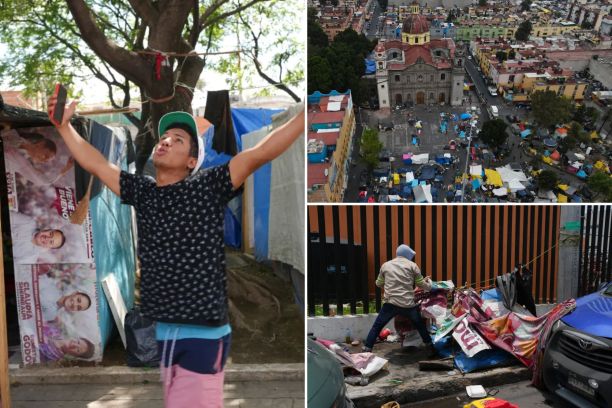INVADER NEWS: US Border Policy Spurs Creation of Massive Migrant Camps — in Mexico City; Migrants Build Makeshift Life in Mexico City While Waiting for US Asylum
US border policy spurs creation of massive migrant camps — in Mexico City
That’s it, dude! Done!,” exclaimed Eliezer López as he jumped up and down, throwing his arms to the sky and drawing a sign of the cross across his chest. His joy was so contagious, his friends started to emerge from nearby tents to celebrate with him.
López, a 20-year-old Venezuelan migrant in Mexico City, had reason to rejoice: after several frustrating attempts, he was able to secure an appointment to seek asylum in the U.S.
He is one of thousands of migrants whose U.S.-bound journey has landed them in the Mexican capital, the southernmost point until recently from which migrants can register to request an appointment to seek asylum through the U.S. Customs and Border Protection’s mobile app known as CBP One.
Since June, when the Biden administration announced significant restrictions on migrants seeking asylum, the app became one of the only ways to request asylum at the Southwest border.
This U.S. asylum policy and its geographic limits are a driving force behind the emergence of migrant encampments throughout the Mexican capital where thousands of migrants wait weeks — even months — in limbo, living in crowded, makeshift camps with poor sanitation and grim living conditions.
From point of transit to temporary destination
Historically, Mexico City has not been a stop for northbound migrants. They try to cross the country quickly to reach the northern border. But the delays in securing an appointment, coupled with the danger that plagues cartel-controlled northern Mexico border cities and the increased crackdown by Mexican authorities on migrants have combined to turn Mexico City from a point of transit to a temporary destination for thousands.
Some migrant camps have been dismantled by immigration authorities or abandoned over time. Others, like the one where López has lived for the past few months, remain.
Like López, many migrants have opted to wait for their appointment in the somewhat safer capital, but Mexico City presents its own challenges.
Shelter capacity is limited, and unlike large U.S. cities like Chicago and New York, which rushed last winter to find housing for arriving migrants, in Mexico City, they are mainly left to their own devices.
Andrew Bahena, coordinator of the Coalition for Humane Immigrant Rights of Los Angeles (CHIRLA) said that up until late 2023 many migrants were contained in southern Mexican cities like Tapachula, near the border with Guatemala. Many tried to disguise their location to defeat CBP One’s geographic limits, but when U.S. authorities took notice, more migrants began aiming for Mexico City to make their appointments from there, he said.
As a result, there has been an increase in the migrant population living in the Mexico City camps.
“We talk about this as border externalization and it’s something the United States and Mexico have been jointly implementing for years,” said Bahena. “The CBP One app is probably one of the best examples of that today.”
“These folks are asylum seekers, they’re not homeless people living in Mexico,” he added. —>READ MORE HERE
Migrants build makeshift life in Mexico City while waiting for US asylum:
“That’s it, dude! Done!,” exclaimed Eliezer López as he jumped up and down, throwing his arms to the sky and drawing a sign of the cross across his chest. His joy was so contagious, his friends started to emerge from nearby tents to celebrate with him.
López, a 20-year-old Venezuelan migrant in Mexico City, had reason to rejoice: after several frustrating attempts, he was able to secure an appointment to seek asylum in the U.S.
He is one of thousands of migrants whose U.S.-bound journey has landed them in the Mexican capital, the southernmost point until recently from which migrants can register to request an appointment to seek asylum through the U.S. Customs and Border Protection’s mobile app known as CBP One.
Since June, when the Biden administration announced significant restrictions on migrants seeking asylum, the app became one of the only ways to request asylum at the Southwest border.
This U.S. asylum policy and its geographic limits are a driving force behind the emergence of migrant encampments throughout the Mexican capital where thousands of migrants wait weeks — even months — in limbo, living in crowded, makeshift camps with poor sanitation and grim living conditions.
From point of transit to temporary destination
Historically, Mexico City has not been a stop for northbound migrants. They try to cross the country quickly to reach the northern border. But the delays in securing an appointment, coupled with the danger that plagues cartel-controlled northern Mexico border cities and the increased crackdown by Mexican authorities on migrants have combined to turn Mexico City from a point of transit to a temporary destination for thousands. —>READ MORE HERE







Comments are closed.